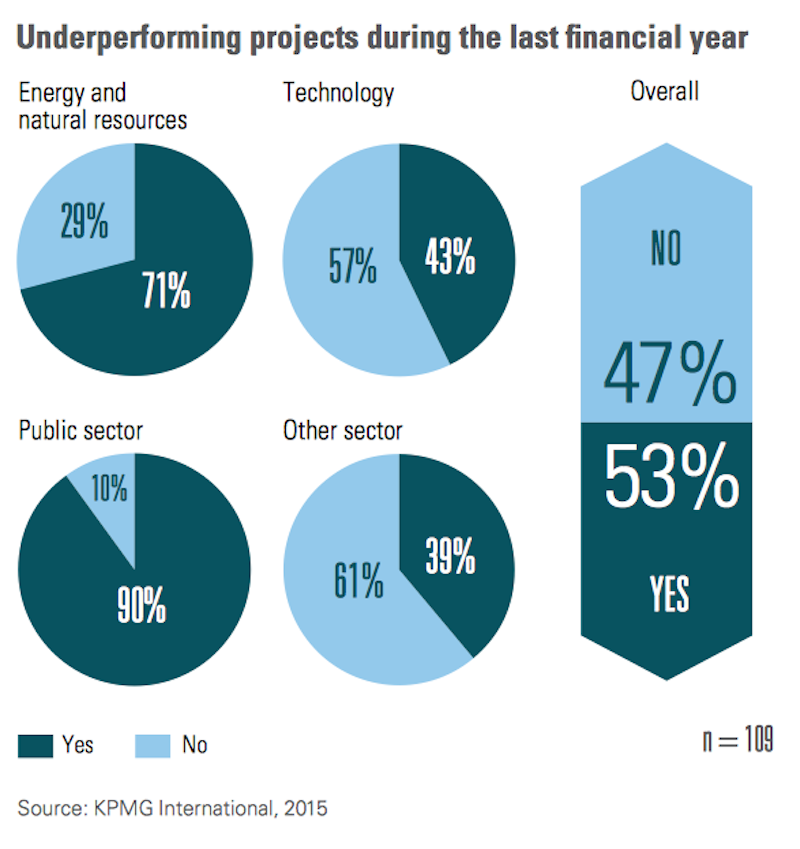Despite their planning and risk management efforts, owners are still finding that a sizable percentage of their projects are either failing or aren’t coming in anywhere near on time or on budget.
More than half—53%—of owners say they suffered one or more underperforming projects in the previous year, a number that rises to 61% for larger organizations, according to KPMG International’s ninth annual Global Construction Survey 2015, based on interviews with 109 senior leaders from private and public organizations around the world that conduct construction activity.
Only 31% of respondents’ projects over the past three years came in within 10% of their budgeted cost. And only one quarter of projects over that period came in within 10% of their original deadlines.
The owners imply that these failures, delays, and overruns are less the result of poor project oversight than of talent shortages and the lack of integration of project management information systems into these companies’ accounting and procurement software programs.

Most owners polled assert that their companies use formal screening, prioritizing, and approval processes for projects, including financial and risk analysis (84%). More than 80% of respondents state that the majority of their capital projects are planned. Thirty percent of respondents use a design-bid-build project delivery strategy, while 32% use engineer-procure-construct.
“All potential projects should be systematically identified, classified, screened, prioritized, evaluated and selected,” writes Jeff Shaw, Director-KPMG in South Africa. “This process must be supported by an appropriate budget allocation and monitoring process. Throughout the capital allocation process, alignment between strategic objectives and the capital project portfolio must be tested.”
The report notes, however, that owners are challenged finding qualified project management personnel. Forty-five percent of respondents say they struggle to attract qualified craft labor, planners and project management professionals.
While 64% of respondents believe their management controls are either “optimized” or “monitored,” nearly one-third concede that their controls are “standardized,” with no testing or reporting or reporting to management and only limited staff training.
Most construction companies rely heavily on software to manage projects. Fifty-five percent of respondents say they are “satisfied” or “mostly satisfied” about the return on investment from project management tools and training. And 73% say they are confident about the accuracy and timeliness of reports they receive from managers and contractors.
However, only about half of respondents say their organizations have introduced an integrated project management information system (PMIS). Consequently, less than one-fifth of respondents could answer “yes” definitively when asked if investments in project governance and controls have reduced project costs.
In planning for delays and cost overruns, senior executives polled identify a range of methods to calculate contingency levels. The two most popular are setting aside an specific amount of contingency for all projects (e.g., 10%), and quantitative risk analysis. “The relative sophistication of the latter suggests that owners are trying to become more accurate in their forecasting,” the report states.
Sixty-nine percent of owners polled say that “poor contractor performance” is one of the biggest reasons for failing projects, delays, or cost overruns. And there’s definitely something negative going when only one-third could say they have a “high” level of trust with pros.
More than eight in 10 respondents expect greater collaboration with contractors over the next five years. How much these relationships actually change, though, remains to be seen. The report suggests that lump-sum, fixed-price contracts, which dominate among the survey’s respondents, are one reason for the fragile state of owner-contractor relationships, primarily because they defer risk onto the contractor. And owners believe the balance of power is shifting toward them; nearly half expect to have more negotiating strength when delivering capital projects over the next five years.
KPMG International offers five steps for owners to improve the performance of their projects:
- Take a fresh approach to talent management through more effective recruitment, development, and retention strategies;
- Execute a fully integrated PMIS for swift coordination and real-time reporting;
- Demand practical targets from contractors based on realistic expectations of what can go wrong;
- Use contingency planning to control costs rather than excuse overruns; and
- Invest in relationships with contractors by creating integrated project teams.

Related Stories
Cultural Facilities | Apr 8, 2024
Multipurpose sports facility will be first completed building at Obama Presidential Center
When it opens in late 2025, the Home Court will be the first completed space on the Obama Presidential Center campus in Chicago. Located on the southwest corner of the 19.3-acre Obama Presidential Center in Jackson Park, the Home Court will be the largest gathering space on the campus. Renderings recently have been released of the 45,000-sf multipurpose sports facility and events space designed by Moody Nolan.
MFPRO+ New Projects | Apr 8, 2024
Construction complete on The Station Apartments in Minneapolis
Big-D Midwest recently completed construction on The Station Apartments at Malcolm Yards, an innovative and unique housing property in Minneapolis.
Green | Apr 8, 2024
LEED v5 released for public comment
The U.S. Green Building Council (USGBC) has opened the first public comment period for the first draft of LEED v5. The new version of the LEED green building rating system will drive deep decarbonization, quality of life improvements, and ecological conservation and restoration, USGBC says.
Codes and Standards | Apr 8, 2024
Boston’s plans to hold back rising seawater stall amid real estate slowdown
Boston has placed significant aspects of its plan to protect the city from rising sea levels on the actions of private developers. Amid a post-Covid commercial development slump, though, efforts to build protective infrastructure have stalled.
Adaptive Reuse | Apr 5, 2024
McHugh Construction completes restoration of Chicago’s historic Ramova Theatre
Adaptive reuse project turns 1929 cinema into a live performance venue, adds a brewery and a taproom, and revives the Ramova Grill in Chicago’s Bridgeport neighborhood.
Retail Centers | Apr 4, 2024
Retail design trends: Consumers are looking for wellness in where they shop
Consumers are making lifestyle choices with wellness in mind, which ignites in them a feeling of purpose and a sense of motivation. That’s the conclusion that the architecture and design firm MG2 draws from a survey of 1,182 U.S. adult consumers the firm conducted last December about retail design and what consumers want in healthier shopping experiences.
Sustainability | Apr 4, 2024
Skanska Elevates Commitment to Sustainability
Skanska, a global leader in sustainable building, has restructured its Sustainability Team to better serve client and company goals. Co-led by Steve Clem and Myrrh Caplan, who together bring decades of experience, the team will allow Skanska to continue to set the bar for the industry.
Codes and Standards | Apr 4, 2024
How Washington, D.C.'s Zero Waste DC Plan impacts building owners and design professionals
On February 8, 2024, Mayor Muriel Bowser presented the Zero Waste DC Plan to the Council, outlining policies, programs, and initiatives to meet the District’s aim of reducing per capita waste generation by 15% and transitioning from a disposable culture to a circular economy. Of the 43 actions in the plan, a handful are essential for building owners and design professionals to know about now.
Healthcare Facilities | Apr 3, 2024
Foster + Partners, CannonDesign unveil design for Mayo Clinic campus expansion
A redesign of the Mayo Clinic’s downtown campus in Rochester, Minn., centers around two new clinical high-rise buildings. The two nine-story structures will reach a height of 221 feet, with the potential to expand to 420 feet.
K-12 Schools | Apr 1, 2024
High school includes YMCA to share facilities and connect with the broader community
In Omaha, Neb., a public high school and a YMCA come together in one facility, connecting the school with the broader community. The 285,000-sf Westview High School, programmed and designed by the team of Perkins&Will and architect of record BCDM Architects, has its own athletic facilities but shares a pool, weight room, and more with the 30,000-sf YMCA.

















